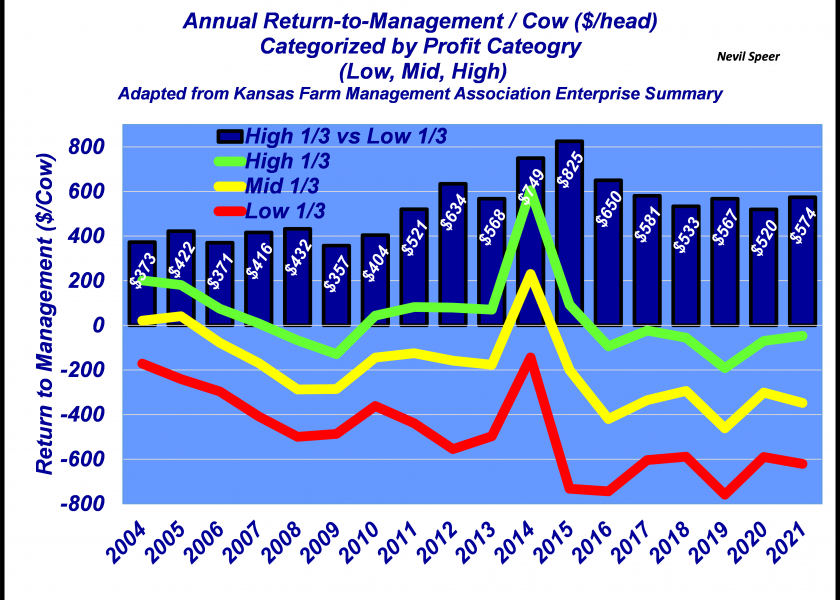Speer: Data-driven Decision Making - Going Through The Middle

Several weeks ago, I highlighted the importance of data-driven decision making. To that end, there are really two parts of that process: 1) obtaining and seeing the evidence / data, and 2) demonstrating the commitment to act upon that information. To illustrate those principles, the column highlighted an illustration from the former VetLife Benchmark data.
Meanwhile, the Kansas Farm Management Association (KFMA) demonstrates the power of data from a different perspective. KFMA is a long-running program with consistent summaries year-after-year. Moreover, the cow/calf enterprise results represent the broader industry well as most participants in the program are mid-size operations. The most meaningful portion of KFMA’s enterprise results is the categorization of operations into thirds (top, middle, bottom) based on profitability.
The revenue side of the business always gets the most attention. That’s understandable because calf marketing is a significant and easily measurable event. To that end, producers generally equate the marketing check to the financial health of the operation.
But that’s a misnomer; marketing success does not equal business success. For example, during the past ten years (’12-thru-’21) the difference between the top and bottom profit groups in terms of marketing weight and price received is relatively small. Operations in the top-profit group averaged only $55/head more revenue versus the bottom-profit group.
What really matters is the mundane and tedious work that occurs on the expense side of the business; it’s far more important than revenue. During the same time frame, the top-profit group possessed an advantage of nearly $350/cow versus operations in the bottom tier. An overwhelming portion of that difference is directly attributable to differences in feed costs: the bottom group spent an extra $180/cow compared to feed costs among the top group.
Now, let’s put all this together in terms of overall profitability. During the past ten years, average per cow return to management values across the three groups were -$583, -$246, and $37 for the low, middle and high profit groups, respectively. In other words, the average difference between the top-and-low profit groups was $620/cow.
For some broader perspective, the bottom group maintains roughly 100 cows – that means an average negative return of $58,300/year. An equal number of cows in the top group returns $3,700. The distinction is plenty big in just one year. But what about running that disparity over ten years? The top-profit group will generate $620,000 more return per 100 cows compared to the bottom-profit group.
All of this brings us back to the broader discussion around data. Clearly, no one wants to be in the bottom-profit group. As noted previously, it’s one thing to see the results, but it’s another to really do something about it. And in this example, real, long-lasting financial success comes from actively managing the cost side of the business. KFMA notes that revenue and production are important, but much less important in explain differences between producers than costs. Underscoring that principle, note that the bottom-profit group failed to generate positive returns even in the best marketing years of 2014 and 2015.
Scott Peck in his great book, The Road Less Traveled, discusses how many people see the beginning and envision the end – but they’re unwilling to go through the middle – they lack discipline to follow-through. Data utilization to drive decision making is conceptually easy to talk about; to really do it, is another matter. But those operations that do implement the discipline to follow through clearly reap the benefits on the other side.
Nevil Speer is an independent consultant based in Bowling Green, KY. The views and opinions expressed herein do not reflect, nor are associated with in any manner, any client or business relationship. He can be reached at nevil.speer@turkeytrack.biz.







